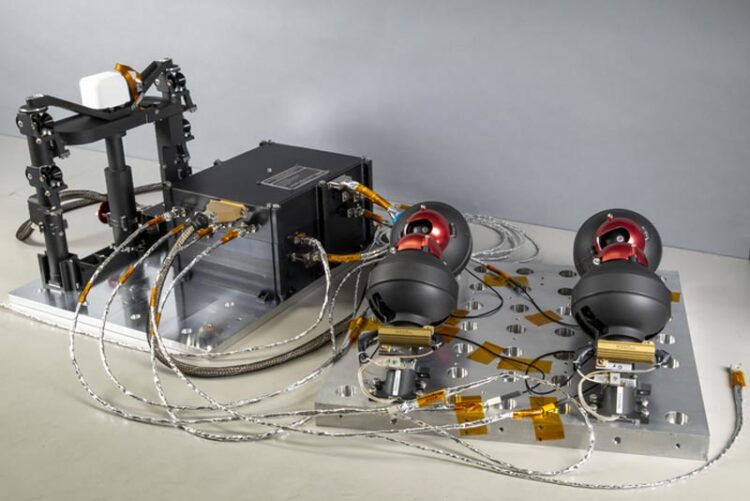SwRI-developed instrument delivered for lunar lander mission

SwRI developed and delivered the LMS instrument for the Mare Crisium lander to determine the electrical conductivity of the interior of the Moon by measuring low-frequency electric and magnetic fields. LMS includes (from left) a magnetometer (white) on an extendable mast, a central electronics box and four spring-launched electrodes.
Credit: Southwest Research Institute
LMS instrument will study electrical conductivity of the Moon’s interior.
Southwest Research Institute recently delivered the Lunar Magnetotelluric Sounder (LMS) to Firefly Aerospace in Cedar Park, Texas, for integration into the Blue Ghost 1 lunar lander scheduled to arrive at the Moon in 2024. The sounder will determine the electrical conductivity of the interior of the Moon by measuring low-frequency electric and magnetic fields.
“For more than 50 years, scientists have used magnetotelluric techniques, which use natural characteristics of the Earth’s electromagnetic fields to determine the electrical resistivity of the subsurface for research and resource exploration,” said SwRI’s Bob Grimm, principal investigator of the instrument. “LMS will be the first extraterrestrial application of magnetotellurics.”
NASA’s Artemis program is series of increasingly complex missions to build a sustained human presence at the Moon for decades to come. To support these goals, LMS is part of a 12-day lunar lander mission to help understand the Moon’s subsurface in a previously unexplored location. LMS is being funded and delivered to the lunar surface via NASA’s Commercial Lunar Payload Services (CLPS) initiative and is expected to land in Mare Crisium, an ancient, 350-mile-diameter impact basin on the Moon that subsequently filled with lava. It is a dark circular spot in the northeast region of the Moon’s nearside that stands apart from the large, connected areas of dark lava to the west of where most of the Apollo missions landed.
These vast, linked lava plains are now thought to be compositionally and structurally anomalous to the rest of the Moon. From its vantage point at Mare Crisium, LMS may provide the first geophysical measurements representative of the overall Moon.
Electromagnetic fields penetrate to greater depths with decreasing frequency, allowing LMS to probe the interior of the Moon to depths up to 700 miles or two-thirds of the lunar radius. The electrical conductivity depends on the temperature and composition of the materials traveling through the field. The measurements will shed light on the differentiation and thermal history of our Moon, a cornerstone to understanding the evolution of solid worlds.
For more information, visit https://www.swri.org/planetary-science.
Media Contacts
Cecilia Novak
Southwest Research Institute
cecilia.novak@swri.org
Deb Schmid
Southwest Research Institute
dschmid@swri.org
All latest news from the category: Physics and Astronomy
This area deals with the fundamental laws and building blocks of nature and how they interact, the properties and the behavior of matter, and research into space and time and their structures.
innovations-report provides in-depth reports and articles on subjects such as astrophysics, laser technologies, nuclear, quantum, particle and solid-state physics, nanotechnologies, planetary research and findings (Mars, Venus) and developments related to the Hubble Telescope.
Newest articles

Innovative 3D printed scaffolds offer new hope for bone healing
Researchers at the Institute for Bioengineering of Catalonia have developed novel 3D printed PLA-CaP scaffolds that promote blood vessel formation, ensuring better healing and regeneration of bone tissue. Bone is…

The surprising role of gut infection in Alzheimer’s disease
ASU- and Banner Alzheimer’s Institute-led study implicates link between a common virus and the disease, which travels from the gut to the brain and may be a target for antiviral…

Molecular gardening: New enzymes discovered for protein modification pruning
How deubiquitinases USP53 and USP54 cleave long polyubiquitin chains and how the former is linked to liver disease in children. Deubiquitinases (DUBs) are enzymes used by cells to trim protein…


